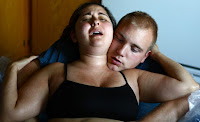Affordability: Cloth diapers average between 15 and 30 dollars per diaper. While it is possible to spread out the cost of cloth buy buying 1 or 2 at a time, this just didn't work for me. I just couldn't justify spending that much money on one diaper no matter how much it would end up saving me.
Quality: You want your diapers to last. Good fabrics are the key. If I am going to make an investment in fluff, I want it to last through all my kids. Also, if your fluff holds up, you will be able to resell it and earn some of your investment back!
Ease of use: I pretty much have to hang my child upside down by the foot to change his diaper. I need a ready-to-go, fast snap diaper. When my son was a newborn, I loved AIO (all-in-one) diapers, but you have to buy those sized. I can't afford to keep buying a whole new stash with each size. I need the diaper to grow with the child.
I first looked into into Lovely Pocket Diapers for the price. 7 dollars for a pocket diaper with insert?! It just seemed too good to be true. I looked up every review I could find on these diapers. If I'm going to invest in fluff, it had better be good. I have yet to find a bad review on these diapers and I can see why.
Initial thoughts upon receiving my diapers:
- Upon first inspection, the diapers appeared to have a good pul outer layer and micro fiber inner layer.
- The snaps are plastic and seem to be punched straight through the fabric rather than pre-punched holes, so they should hold up nicely.
- Microfiber inserts have a silky feel when you first open up a new diaper. Don't worry, they fluff up and are very absorbant, but dont get bulk up.
A month of diaper testing:
So far, I love my LPDs!
- I hang my diapers out in the sun to dry. I was pleasantly surprised with how fast they dry.
- Using a wash without presoak, stains came out of the shells easily with no smell left behind. Soakers tend to hold onto light poo stains and mild smells, but that is easily remedied by a good presoak.
- I was initially concerned that I might have issues with the opening for the inserts. I was afraid that the insert would slip out adn cause problems, but there has never been an issue and I now prefer it.
I have become a huge fan of LPDs. The price of the diapers is unbeatable. The quality has exceeded my expectations. When I did have an issue with some loose leg elastic, I got a prompt response from the owner and excellent customer service. They make their customers feel like part of the family and are very personable. I could not be happier with my diapers or with the company.
I almost have a full stash for my son. I can't wait to start on my newborn stash for January!












































